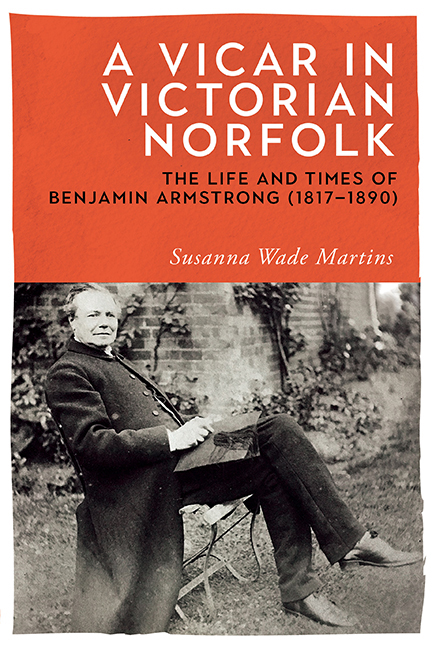Book contents
- Frontmatter
- Contents
- List of Illustrations
- Acknowledgements
- Foreword
- Author's Note
- Map
- Introduction
- I The Early Years
- 1 Early Life
- 2 The Move to Dereham
- II Public Life
- 3 The Norfolk Clergy
- 4 Church Life
- 5 The Building Legacy
- 6 Schools
- 7 Town Life
- III Family and Friends
- 8 Family Life
- 9 Friends
- IV Later Life
- 10 The Later Years
- 11 Armstrong: A Man of His Time
- Bibliography
- Timeline
- Index
2 - The Move to Dereham
Published online by Cambridge University Press: 14 August 2020
- Frontmatter
- Contents
- List of Illustrations
- Acknowledgements
- Foreword
- Author's Note
- Map
- Introduction
- I The Early Years
- 1 Early Life
- 2 The Move to Dereham
- II Public Life
- 3 The Norfolk Clergy
- 4 Church Life
- 5 The Building Legacy
- 6 Schools
- 7 Town Life
- III Family and Friends
- 8 Family Life
- 9 Friends
- IV Later Life
- 10 The Later Years
- 11 Armstrong: A Man of His Time
- Bibliography
- Timeline
- Index
Summary
Happy as he was in Little Stanmore-with-Whitchurch, Armstrong was looking for a larger parish and thus ‘a larger sphere of duty’. The small market town of East Dereham in central Norfolk was suitable for a variety of reasons. Early in 1850 he visited the town with his father and together they decided that it would be a desirable move. Not only was it a larger parish than Little Stanmore with a population of 4,000, but the vicarage was better, the glebe extended to 50 acres and the living was worth more. The annual income from the living (£480) plus the vicarial tithes (£432) would bring his income up to a respectable sum approaching £1,000 a year.
The process of finding a living usually involved recommendation by a patron. Nationally, in 1866 over half of the 6,235 livings in private patronage had been obtained by purchase or as gifts from family members. In at least 1,290 of those livings, the incumbent was likely to be a family member of the patron, as the patron and the parson had the same name. The influential Norfolk families who held the patronage of several parishes would receive a stream of letters from curates or their friends and relations looking for positions. Private patrons were particularly numerous in Norfolk, a county where the local squirearchy was very influential. In 1835 a total of 162 patrons controlled 288 livings. William Andrew was presented with the living of Ketteringham from the sister of the absentee squire and patron, Miss Atkyns, through the efforts of a friend of his wife. The Atkyns family were members of the minor gentry with only the one living at their disposal, but the eleven most powerful members of the aristocracy controlled five or more livings in 1830 and Lord Suffield owned as many as eleven. No members of his family at this date were clergymen, so none of his appointments were to relations, but eight of the eleven were held in plurality. The most valuable, that of Blickling, was held by the Revd Mr J.D. Churchill, who held three others. Thomas William Coke (Lord Leicester from 1834) owned nine, but only one, that of Tittleshall, was worth more than £500 and this was held by his brother-in-law, the Revd Mr E.S. Keppel, who also held a living in the gift of his father, giving him an income of £1,337 a year.
- Type
- Chapter
- Information
- A Vicar in Victorian NorfolkThe Life and Times of Benjamin Armstrong (1817–1890), pp. 47 - 64Publisher: Boydell & BrewerPrint publication year: 2018

